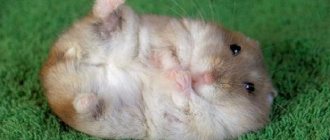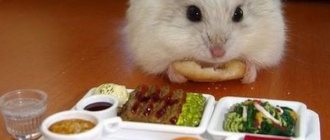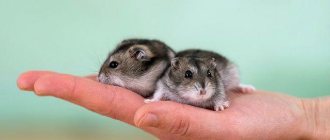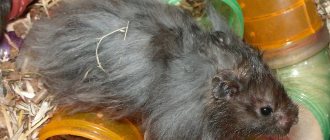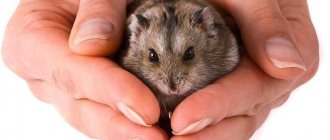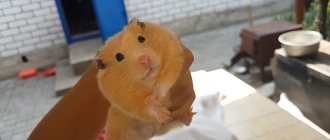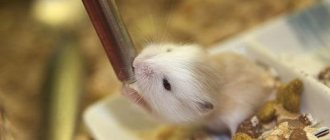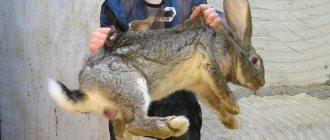Are you planning to get a dzhungarika? It would be wise to familiarize yourself with the rules for keeping the animal in advance and understand how to care for it.
Already have a hamster and have doubts about how to properly care for it? Read the article to the end, and you will have virtually no questions left about the care, maintenance and nutrition of the Djungarian hamster at home.
Proper care means a happy hamster!
Choosing a house for a dzhungarik
It is most convenient to keep and care for a Djungarian hamster in:
- cage
- dune
- large aquarium (with good ventilation)
- terrarium
- rack
Let's look at each option in a little more detail.
Cell
A cage is one of the most convenient homes for keeping a hamster. Most importantly, when purchasing, pay attention to the following points:
- The pallet is preferably plastic. Wooden is chewed, and it absorbs odors.
- For ease of maintenance, it is better to take it with a removable tray.
- Choose higher plastic sides: less filler will fly out of the cage.
- The rods must be metal (again, so as not to be chewed).
- Choose a cage with small distances between the bars. Djungarians are so small that they crawl between them, and it is impossible to keep them in such a house.
- The recommended bottom size for one animal is approximately 30x50 cm.
- Inspect the entire structure: there should be no burrs, sharp edges or protruding ends of the wire anywhere. The baby is easy to hurt.
Dune
Dunes for keeping rodents are becoming increasingly popular. And for good reason. The advantages of such houses:
- the sides are solid: no matter what games the Djungarians play, there will be no filler on the floor;
- even the smartest hamster will not be able to open the door in the “ceiling”;
- the upper part is transparent, you can clearly see what the animals are doing;
- small dunes can be used as portages;
- very easy to clean thanks to its simple and well-thought-out design.
There are also mixed options for keeping, which can be called “cage dunes”. Typically in these dunes, more sections of metal cage are inserted between the tray and the lid. This way you can increase the height and provide ventilation.
You can buy ready-made houses of any variety here (there are both budget options and luxury “villas” for keeping a pet).
Dune, cell and their hybrid.
Aquarium
Keeping hamsters in an aquarium is not recommended. The fact is that they are usually narrow and poorly ventilated. In addition, if the aquarium is glued together and not solid, poisoning from the glue is possible (rodents taste everything).
The advantage of keeping it in an aquarium is that you can clearly see how your pet plays. Children especially appreciate this. If you buy an aquarium that does not contain harmful substances and provide a flow of fresh air (forced ventilation), then there will be no harm to your Djungarian pet.
Terrariums and glass shelving
This is a good option for keeping (subject to a minimum bottom size of 30x50 cm). Everything is visible, very spacious and (in the case of shelving) takes up little space. The only drawback is that care is not very convenient. An excellent choice for breeding Djungarian hamsters, but for one individual there is probably no point in such a large house.
Houses made from scrap materials
Based on the size requirements (30x50 for one rodent) and ventilation, tiny options such as a jar or cardboard box are immediately eliminated: high-quality care and maintenance of a Djungarian hamster in them is impossible. Otherwise, complete freedom for your ideas. The main thing is to ensure sufficient size and air flow.
Not that I'm complaining, but isn't there something bigger?
What does a hamster need in a cage?
List of what you need to keep a Djungarian hamster:
- small house for sleeping and storing supplies
- running wheel and/or labyrinth (required)
- food utensils
- drinking bowl
- mineral stone
- twigs for grinding teeth
- filler
Do not rush to “fix” all the objects in the cage according to your own design. First, let the dzhungarik determine a place for the toilet. And only then place food, water and a mini-mink as far away from it as possible.
Gym for dungarians
The running wheel is not intended for family observation of the hamster running in it, it is necessary for the health of the hamster. In nature, a hamster runs up to 12 km per night in search of a “snack.” When kept at home, there are 20 centimeters before eating, so the Djungarian hamster will quickly begin to gain fat. Given the tendency of this type of hamster to develop diabetes, obesity will end very badly. The rodent needs to engage in “sports”.
In addition to the wheel, a labyrinth of pipes “works great” - a small Djungarian hamster runs through them no less willingly than in a wheel. Interesting options for maintaining physical fitness can be found in the sections of the store with accessories and toys.
Excellent “apartment” with everything you need. And the area is okay...
Filler
We advise you not to use scrap materials as bedding in the house. Fibrous materials (for example, cotton wool) are strictly prohibited - the dwarf is tiny, it can get entangled in them. The preferred option for “homemade” fillers is finely chopped paper and napkins. The main thing is to make sure that it is without flavorings and printing ink. Paper with sharp edges (like office paper) is also unacceptable.
The best choice for caring for the dwarf is ready-made granular fillers, an abundance of which can be found in this pet store. As an alternative, you can use self-harvested sawdust (but not in the form of fine dust - it gets into the respiratory tract).
That's it. Owner, respect!
Teeth sharpener and mineral stone
The Djungarian hamster's teeth grow constantly (like your nails), so care is indispensable without a “sharpener.” These can be small branches of trees or bushes. You can prepare it yourself (an excellent option is an apple tree) or buy ready-made ones in the store. If you don’t foresee how the hamster will wear down his teeth, he will start gnawing everything around, starting with his home.
The hamster also needs a mineral stone to replenish microelements in the body.
Health problems
Most often, hamsters are susceptible to obesity and diabetes.
- Obesity.
To avoid this scourge, it is necessary to select a spacious home for the rodent, because Djungarian hamsters run a lot and are very active. For this they need space. With low activity, the pet will quickly gain unwanted weight , which will have a detrimental effect on its health and life expectancy.
IMPORTANT! If obesity does happen, then diet and physical activity (mazes, walking ball) will help get rid of it.
- Diabetes.
Sometimes diabetes is inherited by a hamster, but most often the breeder is to blame for pampering his pet too much with tasty food that is not healthy for him.
Symptoms include sudden changes in behavior, changes in body weight, excessive drinking and urination.
If you have diabetes, a diet with plenty of vegetables and protein is prescribed.
- Inflammation of the cheek pouches.
An animal can injure its mucous membrane when it eats seeds and nuts in shells or dry pasta. The wound becomes dirty and inflamed, leading to an abscess that needs to be cleaned out.
IMPORTANT! You cannot get rid of an abscess on your own. It is necessary to contact a specialist who will also prescribe the necessary antibiotic.
- Malocclusion.
To avoid malocclusion in your hamster, it is important to maintain a balanced diet. There should always be twigs or mineral stones in the cage, on which the animal will grind its teeth.
- Indigestion.
You should not give your pet foods from the list of prohibited foods; this can cause bloating, constipation, diarrhea, and even severe poisoning.
IMPORTANT! Dill water will help with bloating. Flax seed mucilage or petroleum jelly will help relieve constipation. In case of poisoning, sorbents from a home medicine cabinet, for example, smecta, are suitable, but in tiny dosages.
- Skin diseases and bacterial infections.
To prevent this from happening, you need to keep your pet’s home clean, wash fruits and vegetables, wash your hands before contacting the rodent, and choose high-quality dry food and cage litter. Hamsters can also catch a cold if exposed to a draft.
If you suspect any disease, you must consult a specialist immediately.
Where to put the cage
The peculiarity of caring for a Djungarian hamster is that it is a nocturnal animal. And you won’t be able to train him to stay awake during the day. Don't forget to remind the children not to bother the dwarf with games all day - hamsters sleep during the day.
Based on this, we choose a place to keep the rodent. The house should be placed away from direct sunlight. This should not be the living room or kitchen (too noisy during the day). The bedroom is also not suitable (the dwarf spends the night actively, and this will disturb you). As an option, you can transport the house to the bedroom in the morning and to the kitchen in the evening. Also, you can’t place it in a draft, but you need to provide access to fresh air.
Description of the breed
Color and length of rodent fur
The hamster is distinguished by a dark gray stripe on its back, white belly and paws. The ears are dark, but light inside. In summer, rodents are predominantly pearl-colored, and in the cold season they change it to snow-white.
Changing color in winter is more common for animals in the wild to protect themselves from predator attacks.
The coat is short and fluffy.
Length and weight of Djungarian hamsters
The length of the hamster is from 70 to 90 mm, the length of the tail is from 5 to 15 mm.
Throughout the year, the weight of the rodent changes noticeably, especially in winter, the hamster becomes noticeably lighter.
Males weigh from 19 to 45 g, females - from 19 to 36 g. Domestic hamsters are slightly heavier than their wild counterparts.
Character of the Djungarian hamster
The hamster is much more willing to live alone. When a neighbor of the same sex moves in with him, a serious conflict can flare up. These cute-looking rodents are capable of displaying unprecedented aggression and cruelty in the fight for territory.
IMPORTANT! In a mixed-sex neighborhood, the offspring will not keep you waiting! Think several times about whether you are ready to expand your family.
Hamsters of the same sex can get along together if they have been around since birth, but even this does not guarantee the absence of disputes and fights.
The animal is friendly towards humans , willingly goes into hands, loves to be petted and can easily fall asleep on one’s lap.
Do you have one jungarik or several?
Sometimes Djungarians live up to 4 years
Cage care rules
A few words about how to care for a dwarf's house. Good care involves cleaning at least once a week. Or better yet, 2. It must include:
- replacing bedding
- wet cleaning
- removing leftover food from the pantry
- washing hamster "dishes"
Carry out grooming when your Djungarian pet is away from its cage - it does not like strangers. Do not throw away all the food at once - this can lead to severe stress for the dwarf. Remove only perishable items, such as grains, nuts, etc. leave it in place.
If the animal’s cage is very dirty and you have to use a detergent, then you need to choose a hypoallergenic and odorless one - a foreign aroma can scare away the Djungarian hamster; Because of such “leaving,” the dzhungarik will refuse to return to the house.
Where did the breed come from?
The first mention of the Djungarian hamster dates back to 1773. They were discovered by the German scientist P.S. Pallas, who spent a lot of time in Russia. He described the breed as a Zungor mouse with a short head and huge cheeks right up to the shoulders.
In the wild, Djungarian hamsters live in Western Siberia, Central and Central Asia and Northeastern Kazakhstan. They were also spotted in Altai. They are rarely found in Canada or the USA.
The cute rodents instantly made people fall in love with them. The hamsters turned out to be curious, very active and easy to care for. The animal moved from the steppes to spacious cages without much difficulty.
Over time, the domestic rodent began to noticeably differ in fur color from its wild counterparts.
Hamster changes color throughout the year
Is it possible to house a dzhungarik alone?
Not only is it possible, but it is also necessary. You cannot keep a Djungarian hamster in the same cage with other animals (including hamsters) if you care about your pet. They are “selfish” animals, they don’t like their neighbors, they don’t make friends :). And if you put two same-sex people together, then expect trouble in the form of fights and possible injuries. It is better to care for several hamsters separately. Different sexes can be kept in the same house only for reproduction.
Friendship is friendship, but housing is separate
The right pallet: what is it?
This is a structural element, a kind of “latrine pit” of the cell. Garbage and crumbs are poured here, and waste flows out. There are several types of pallets.
The division occurs on the basis of the mechanism of action (retractable), material of manufacture, size.
Housing for a Djungarian hamster must be equipped with a deep tray. During their games, individuals scatter the filler, and the high walls of the tray will not allow debris to fly out of the cage.
Reproduction of Djungarian hamsters
So how can dzhungarikas reproduce if they cannot be housed together? They need to be kept in separate dwellings, placed together only for the duration of mating (this can be done as soon as the female starts estrus). We perform mating on neutral territory or in the male’s house. To avoid making a mistake in choosing gender, read a detailed “manual” on its definition here. Otherwise, it may turn out that you looked after Khomka like Pushinka.
The ideal age for the first mating is 4-5 months. The period between matings for a female is at least 2.5 - 3 months. In total, a healthy hamster can give birth to up to 6 litters of small rodents; subsequent pregnancies are fraught with health problems for both the mother and the little hamsters.
When the female becomes pregnant, we seat the “newlyweds” back in their cages. A week before giving birth (maximum 5 days), we completely stop caring for the pregnant female’s cage and do not handle it. We just add food and water (do not forget to increase the content of animal protein in the diet of a pregnant Dzungarian female).
The birth of small hamsters will most likely take place at night and unnoticed. After a couple of weeks, add a separate water bowl and a smaller food bowl - small hamsters may be high up to "adult size". Babies can be placed 4 weeks after birth, boys and girls in different housing.
Try to guess where Khomka is and where Pushinka is...
What to feed the dwarf
Here we will give general recommendations on how to feed your Djungarian hamster. If you want to learn more about the nuances of proper nutrition for your rodent, read our article.
The basis of the diet of the Djungarian hamster in nature is seeds and cereals. For home care, we recommend sticking to the same menu. A good option is ready-made mixtures that can be bought in the store (they also sell treats there). Dried herbs, minerals, and vitamins are often added to them. The main thing is to buy food specifically for hamsters: food for other rodents and birds is not suitable.
If purchasing is unacceptable to you for some reason, watch the video on how to prepare the mixture yourself (below).
Cereals and seeds
The best cereals for dzhungarika (the content of harmful substances is minimal):
- oats
- wheat
- barley
- rye
- corn (in limited quantities)
You don’t need to give as many seeds as cereals, because... they have a high fat content. The Djungarian hamster can be fed with seeds:
- sunflower
- pumpkins
- sesame
- flax
Fruit seeds and seeds are strictly prohibited. They contain substances that can kill such a small animal as the dwarf.
The train of thought is correct, but you need to pour less.
Nuts
Nuts have a strong disadvantage - high calorie content and fat content (do not forget about the tendency of Djungarian hamsters to obesity). Sometimes (as a treat, and not constant feeding) the dzhungarika can be offered:
- Walnut
- cashew
- peanut
- hazelnut
Due to the content of harmful substances, you cannot feed these types of nuts:
- Brazilian
- almond
- cedar
Vegetables
For the Djungarian hamster, all vegetables should be divided into two categories: high-starch and low-starch. Avoid foods with a high starch content - this is an easily digestible carbohydrate, an excess of which in the diet leads to obesity and diabetes.
The most preferred vegetables in the diet:
- cabbage
- broccoli
- cucumber
- bell pepper
Absolutely not (contain a lot of easily digestible carbohydrates):
- potato
- boiled carrots
- boiled pumpkin
If you have doubts whether your baby can eat this or that vegetable, refer to the glycemic index tables of foods. What is harmful to humans is also harmful to your dwarf.
Vegetables are only low-starch and high in fiber.
Fruits and berries
For these products, we can give the following recommendation: strongly sweet fruits and berries are not allowed (watermelon, melon, peach), moderately sweet and sour ones are allowed (strawberries, cherries, currants).
In general, it is difficult to give specific instructions here: the content of fruit sugar (fructose) can vary greatly depending on location, growing method and weather. Therefore, in any case, give fruits and berries in limited quantities.
Protein
Despite the fact that the Djungarian hamster prefers plant foods, its diet should include animal proteins (a couple of times a week, and for pregnant and lactating females - a little every day). In nature, insects serve as protein snacks. You can buy them dried in pet stores. You can replace insects with low-fat boiled chicken or fish, egg whites - their fat content is minimal.
I ate everything, give me more!
